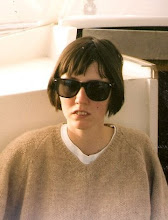'The artist must make time for long periods of solitude. An artist should suffer. The artist must develop an erotic point of view on the world. An artist should avoid falling in love with another artist. The funeral is the artist's final art piece before leaving.'
In the first few rooms there were several videos of performances created through the collaboration of Abramovic and German performance artist Ulay. This collaboration lasted over a decade and was of the type that each artists individual identity was effaced by the partnerships conceptual and aesthetic concerns. Their goal was to overcome the artistic ego. I like the way that as their partnership went on, Abramovic and Ulay began to look more and more alike.
Abramovic/Ulay, AAA-AAA, 1977
The two artists draw breath and then yell and howl at one another over and over again. Sometimes it seems like one or the other is getting the upper hand....drowning out the others voice, or dominating. It's like an argument. Emptying the body and flaying the vocal cords, the male and female energies battle it out.
Abramovic/Ulay, Breathing In/Breating Out, 1976
I find this work a beautiful metaphor for the destructiveness of co-dependancy in relationships. Locking mouths together Abramovic/Ulay breath one anothers air until their is no oxygen left and both artists collapse unconscious.
Abramovic/Ulay, Rest Energy, 1980
Again, this performance really speaks to me of the fraught nature of romantic relationships. The delicate balance between love, obsession, harm and tenderness. I just finished reading 'Monkey Grip' by Helen Garner, so perhaps this theme is on my mind. In this performance the artists face one another down, delicately leaning and jostling, with the arrow aimed directly at Marina's heart. The violence is implied, possible, dependent on mutual concentration and effort.
Marina Abramovic, Confessions, 2010
In this work, Abramovic whispers confessions and memories from her childhood to a donkey. I don't know what the donkey thought of them. They were subtitled onscreen. They seemed like a continuous dream narrative.
There was an interesting room that had drawers filled with notes, photos and observations. It was interesting that there were several photographs from Abramovic's travels in the Northern Territory and Central Australia. I wonder if she sought permission to reproduce images of the Indigenous people she photographed. I hope so. I've found the way that Abramovic has discussed Indigenous cultures to be slightly fetishistic in the past. I was interested by this performance by Ben D'Armagnac. It seems prophetic that the artist made a work about the destructive powers of water and then drowned a week later.
After poring through this room, I took the opportunity to participate in the Abramovic Institutes 'Counting Grains of Rice' performance. Performers are given a lab coat and sound-canceling headphones, before entering a room with a long table. Along the centre is a mound of rice and black lentils. Assistants scoop a cup of grains and place them before you with a pencil and piece of paper. The goal is to tally how many of each grain. But how to do it? What kind of systematic method to use? I laid my grains out in a grid in groups of ten grains. I only lasted about 40 minutes before the futility of the task got to me. I understand that meditation is the purpose of the exercise....and it was a great experience, but I really wanted to get outta there.
Marina Abramovic, The Onion, 1996
She ate the whole onion. Tears of ouch.
Marina Abramovic, Golden Mask, 2010
The only movement in this is the gentle rustle of the gold leaf in the breeze. What does it mean? Abramovic's characteristically hypnotic gaze is there.....but I'm not sure what the gold is for. Does it relate to her art-celebrity status? To the artistic tradition of sculpture and religious art? I don't know.
Overall, I really enjoyed this exhibition. It included some artworks that have influenced me immensely as a performance artist. Abramovic is formidable in that she has pushed the limits of physical and mental endurance, as well as bringing performance art to the mainstream.
Here are some of my other faves from MONA:
Forget who this is by.
Wim Delvoye, Cloaca, 2012
Aye, the poop machine. It smelt horrible. It was kind of awesome to see the 'food' swirling around in the glass stomachs. Felt bad for the person who had to sit this room though.
Forget who this video work was by....but I like it. Trippy.
And finally, there was a live stream of Christian Boltanski's studio playing in a little bunker right next to where you take the ferry. Which I thought was AWESOME!
'Private Archaeology' on until October 5th.
MONA
655 Main Road, Berriedale TAS 7011
